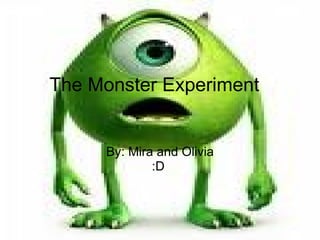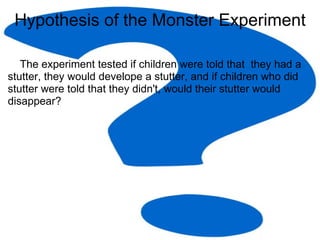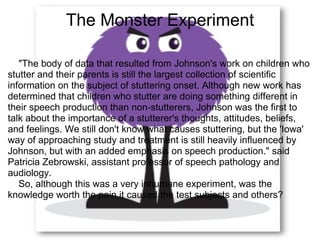T He Monster Experiment
- 1. The Monster Experiment By: Mira and Olivia :DÂ
- 2. Hypothesis of the Monster Experiment    The experiment tested if children were told that  they had a stutter, they would develope a stutter, and if children who did stutter were told that they didn't, would their stutter would disappear?
- 3. The Test Subjects and Test Groups    There were 22 orphans, from ages 5-15, and none of them were aware that they were being experimented on.     Ten children with stutters were divided into two groups, 1A and 1B. The other twelve were divided randomly in half, and six went to 1A, and six went to 1B.
- 4. What The Experiment Did    1A was made up of stutterers and non-stutterers, they were told that they had no speech problems, or that it was just a phase that would eventually pass.    1B was made up of stutterers and non-stutterers and were told that they had a major problem, and in order to prevent it, they may only speak when what they wanted to say could come out correctly.  Â
- 5. What Happened to Group 1A Â Â Â The information we used did not describe the effects that the experiment had on the children that made up group 1A.
- 6. What Happened to Group 1B Â Â Â The orphans who did not stutter and were told that they did became reluctant to speak, and after a few weeks, some stopped speaking all together. Their reason for doing this was so that nothing that they said would come out wrong. Â Â Â One girl said "A" before every word and later, snapped her fingers. Â Â Â When asked why, She explained that she said "A" because she was afraid that she would say the next word wrong, and then snapped her fingers because she was afraid she was going to say "A". Â Â Â Much like her the children tried to diceplin themselves, but their attempt turned out to only cause more damage.Â
- 7. More on 1B    One girl stopped talking to her friends, for fear that they would notice her "stutter" which she did not have. later, she ran away from the orphanage and eventuall yended up at another school.     Another warned that he wouldn't be able to say the next word, because it seemed stuck in his throat.    Orphans were disciplining themselves so much that sometimes they had no time for school. Some just stopped talking entirely, and wouldn't even talk to their friends.Â
- 8. How This Experiment Affected the Test Subjects' Lives    The non-stutterers who were told that they had a stutter became shyer in class, and either became reluctant/self concious to speak didn't say anything at all.         Teachers wrote that their students didn't talk at all, and their grades dropped because they wouldn't speak in front of the class. A teacher reported that one boy didn't even look up, and kept his face hidden for the entire day.Â
- 9. What The Test Subjects Got       The test subjects didn't get anything until their later lives. Then, only 6 of the test subjects got $925,000 for life long psychological and emotional trauma caused by the torment that they were put through during the Monster Experiment.Â
- 10. The Monster Experiment    "The body of data that resulted from Johnson's work on children who stutter and their parents is still the largest collection of scientific information on the subject of stuttering onset. Although new work has determined that children who stutter are doing something different in their speech production than non-stutterers, Johnson was the first to talk about the importance of a stutterer's thoughts, attitudes, beliefs, and feelings. We still don't know what causes stuttering, but the 'Iowa' way of approaching study and treatment is still heavily influenced by Johnson, but with an added emphasis on speech production." said Patricia Zebrowski, assistant professor of speech pathology and audiology.    So, although this was a very inhumane experiment, was the knowledge worth the pain it caused the test subjects and others?
- 11. What Was Done to Help the Test Subjects    In addition to recieving money, Mary Tudor helped many of the test subjects both while they were still children and continued to help them when they were adults and others with speech therapy. She did this because as she said in her letter to Johnson, she thought that what they had done was not right.
- 12. Do you think that it was wrong to use orphanage children? Do you think the information gathered was worth the physiological damage inflicted upon the orphans? If you could design the experiment again, without inflicting physiological damage, what would you do? If you were one of the kids in group 1B, how do you think you would react? Do you think the money given to 6 test subjects was sufficient to the trauma they went through?
- 13. Sources http://en.wikipedia.org/wiki/The_Monster_Study  http://www.cs.sunysb.edu/~mueller/teaching/its102/monsters_inc_pic_02.jpg http://www.highestfive.com/wp-content/uploads/wendell-johnson-monster-study.jpg (image) http://upload.wikimedia.org/wikipedia/commons/thumb/b/b2/Blue_question_mark.svg/450px-Blue_question_mark.svg.png http://www.sl-designs.com/images/free-backgrounds/0smiley-crying_sl-designs-sm.jpg http://www.dhs.state.mn.us/DSDTraining/WebManRpt/Images/silence.gif http://rlv.zcache.com/cute_fuzzy_purple_monster_poster-p228273944246598846t5wm_400.jpg http://www.harrycutting.com/graphics/photos/children/depressed-sad-child-J163-24-11LG.jpg http://www.cmc-northeast.org/images/speech_therapy.jpg
- 14. Class questions and answers. Â Â














